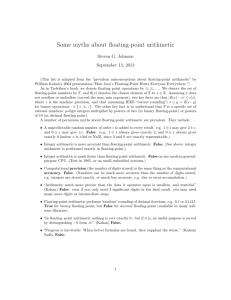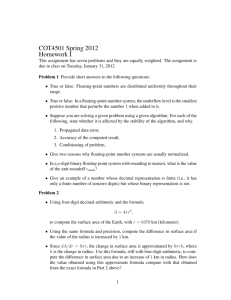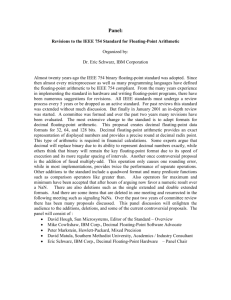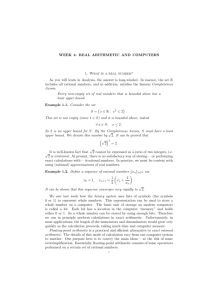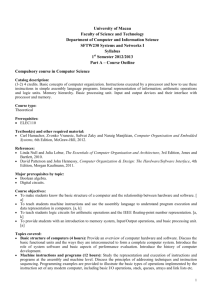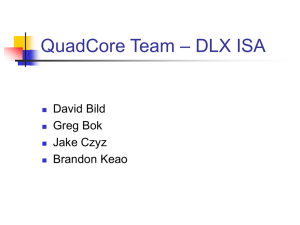Paper
advertisement
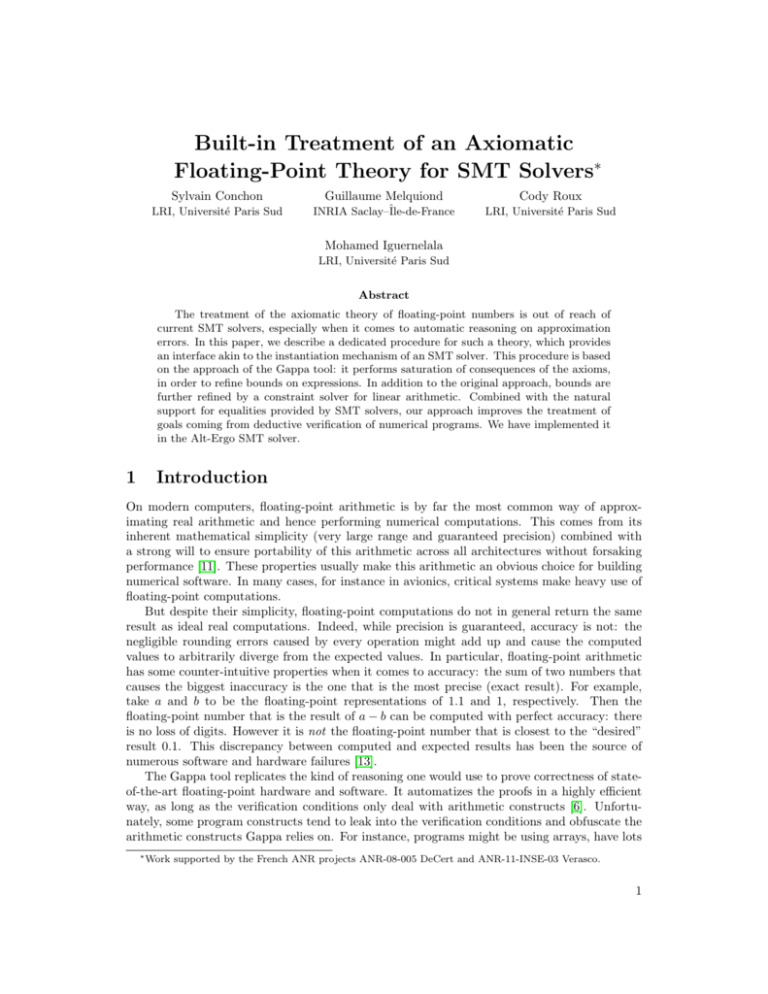
Built-in Treatment of an Axiomatic
Floating-Point Theory for SMT Solvers∗
Sylvain Conchon
Guillaume Melquiond
Cody Roux
LRI, Université Paris Sud
INRIA Saclay–Île-de-France
LRI, Université Paris Sud
Mohamed Iguernelala
LRI, Université Paris Sud
Abstract
The treatment of the axiomatic theory of floating-point numbers is out of reach of
current SMT solvers, especially when it comes to automatic reasoning on approximation
errors. In this paper, we describe a dedicated procedure for such a theory, which provides
an interface akin to the instantiation mechanism of an SMT solver. This procedure is based
on the approach of the Gappa tool: it performs saturation of consequences of the axioms,
in order to refine bounds on expressions. In addition to the original approach, bounds are
further refined by a constraint solver for linear arithmetic. Combined with the natural
support for equalities provided by SMT solvers, our approach improves the treatment of
goals coming from deductive verification of numerical programs. We have implemented it
in the Alt-Ergo SMT solver.
1
Introduction
On modern computers, floating-point arithmetic is by far the most common way of approximating real arithmetic and hence performing numerical computations. This comes from its
inherent mathematical simplicity (very large range and guaranteed precision) combined with
a strong will to ensure portability of this arithmetic across all architectures without forsaking
performance [11]. These properties usually make this arithmetic an obvious choice for building
numerical software. In many cases, for instance in avionics, critical systems make heavy use of
floating-point computations.
But despite their simplicity, floating-point computations do not in general return the same
result as ideal real computations. Indeed, while precision is guaranteed, accuracy is not: the
negligible rounding errors caused by every operation might add up and cause the computed
values to arbitrarily diverge from the expected values. In particular, floating-point arithmetic
has some counter-intuitive properties when it comes to accuracy: the sum of two numbers that
causes the biggest inaccuracy is the one that is the most precise (exact result). For example,
take a and b to be the floating-point representations of 1.1 and 1, respectively. Then the
floating-point number that is the result of a − b can be computed with perfect accuracy: there
is no loss of digits. However it is not the floating-point number that is closest to the “desired”
result 0.1. This discrepancy between computed and expected results has been the source of
numerous software and hardware failures [13].
The Gappa tool replicates the kind of reasoning one would use to prove correctness of stateof-the-art floating-point hardware and software. It automatizes the proofs in a highly efficient
way, as long as the verification conditions only deal with arithmetic constructs [6]. Unfortunately, some program constructs tend to leak into the verification conditions and obfuscate the
arithmetic constructs Gappa relies on. For instance, programs might be using arrays, have lots
∗ Work
supported by the French ANR projects ANR-08-005 DeCert and ANR-11-INSE-03 Verasco.
1
An Axiomatic Floating-Point Theory for SMT Solvers
Conchon, Melquiond, Roux, and Iguernelala
of different execution paths; as a side-effect of their generation process, verification conditions
might be littered with useless lemmas and equalities. All of these issues are the cause for extra
work from the user and hence partly defeat the point of automatizing the process.
On the other hand, SMT solvers, which are ubiquitous in deductive program verification,
are especially designed to handle these issues. They have built-in theories of arrays and congruences and specialized algorithms for instantiating lemmas, they depend on SAT solvers for
propositional logic, and so on. Floating-point numbers are not presently handled by most SMT
solvers, although there is a proposal to add them to the SMT-LIB 2 standard [14]. This would
allow a complete description of the bit-level representation of IEEE-754 floating-point numbers
and operations, including exceptional values. However error analysis is out of the scope of such
a description, as there is no way to embed floating-point values into real numbers.
In this paper, we present a way to implement the proof mechanism of Gappa inside an
SMT solver to allow reasoning on approximation errors in a theory of reals with floating-point
operators. Section 2 describes the proof mechanism of the Gappa tool. Section 3 explains the
limits of a purely axiomatic approach to integrating floating-point reasoning in an SMT solver.
Section 4 presents a description of the integration of the procedure as a built-in instantiation
based algorithm. Section 5 gives an example that uses the most salient features of the algorithm.
2
The Gappa Tool
Gappa is a tool dedicated to proving the logical formulas that usually occur when verifying the
numerical correctness of a program [5]. These formulas are described by the following simple
grammar:
prop
::= ¬prop | prop ∧ prop | prop ∨ prop | prop ⇒ prop | atom
atom
::= expr ≤ number | expr ≥ number | expr = expr
expr
::= ident | number | − expr | abs(expr ) | sqrt(expr )
| expr expr | rnd... (expr )
with ∈ {+, −, ×, /}. The semantics of these formulas is, for the most part, straightforward:
identifiers are mapped to universally-quantified variables of real type, arithmetic operators and
relations are mapped to the corresponding symbols of real arithmetic, and logical connectives
are given their usual propositional meaning.
2.1
Rounding operators
Rounding functions are sufficient to express computations that occur inside a numerical program, thanks to the philosophy that underlies most computer arithmetic. For instance, consider
the IEEE-754 standard for floating-point arithmetic [11] that describes the behavior of most
floating-point units you will find in modern processors. It states: “a floating-point operator
shall behave as if it was first computing the infinitely-precise value and then rounding it so
that it fits in the destination floating-point format”, assuming the inputs are not exceptional
values. As a consequence, a floating-point addition between two floating-point numbers u and
v should behave as if it was rnd... (u + v) for some properly parametrized rounding operator.
For instance, if the destination format is binary32 from IEEE-754 and if the rounding
direction is the default one, then rnd(x) satisfies the following properties: it is a real number y
such that there are two integers m and e with y = m · 2e , |m| < 224 and e ≥ −149. Moreover, it
2
An Axiomatic Floating-Point Theory for SMT Solvers
Conchon, Melquiond, Roux, and Iguernelala
is the number that minimizes the distance |y − x|. Finally, if there are several such numbers,1
then y is chosen so that it can be represented with a mantissa m that is an even integer while
still preserving e ≥ −149. Note that there is no upper bound on e as overflow is generally
handled by a separate analysis. Floating-point arithmetic is standardized in such a way that it
is always the case that there exists one and only one such number.
2.2
Proof Mechanism
When given a logical formula to prove, Gappa starts by performing some manipulations until
it reaches an equivalent problem consisting of a disjunction of formulas of the following form:
t1 ∈ I1 ∧ . . . ∧ tn ∈ In ⇒ ⊥.
Terms t1 , . . . , tn are Gappa expressions, while I1 , . . . , In are intervals with numerical bounds.
Actually, Gappa handles more predicates than just membership in an interval [6], but for the
sake of simplicity, they will not be mentioned here.2
Gappa has a database of over 200 theorems which can be split into three categories. The
first deals with real arithmetic, e.g. knowledge about square roots. The second category handles
rounding operators and computer formats. The third category is composed of rewriting rules
that simulate reasoning similar to that of forward error analysis.
Gappa applies these theorems on the hypotheses of the logical formula by a saturation
mechanism, in order to deduce new facts. It keeps going until a contradiction is deduced or no
new facts are found. Note that the tool is not guaranteed to terminate, and even if it does, an
absence of contradictions does not mean that the property is true.
Theorems about real arithmetic and rounding operators have the following form:
∀~x, ∀I1 , . . . , In , I,
f1 (~x) ∈ I1 ∧ . . . ∧ fn (~x) ∈ In ∧ P (I1 , . . . , In , I) ⇒ f (~x) ∈ I.
Expressions f1 , . . . , fn , f are specific to a given theorem, and so is the relation P between
intervals. Moreover, Gappa knows some partial function h such that P (I1 , . . . , In , h(I1 , . . . , In )).
From the point of view of Gappa, even rewriting rules fit this model: n = 1, P is ⊆, and h is
the identity.
2.3
Theorem Instantiation
Gappa first performs symbolic backward reasoning for all the terms t1 , . . . , tn that appear on
the left-hand side of the original formula. The heuristic is that, if a contradiction is to be
found, then it will be with one of the original bounds. It therefore searches which theorems
have a conclusion that could be used to compute a bound for one of the original terms. The
hypotheses of these theorems are enclosures too, so Gappa searches recursively on their terms
too. The search proceeds in a manner similar to Prolog, as the theorems have the form of
Horn clauses. The procedure stops when it finds that it needs to bound one of the terms of the
original formula. In practice, this backward search terminates since theorems have been chosen
so that the terms on the left-hand side are somehow smaller than the term on the right-hand
side. This solves the issue of the set of terms being unbounded, but not the issue of finding
instances for every ~x, except that this time, the uninstantiated variables are on the left. Gappa
relies on various heuristics to fill the holes.
1 In
other words, x is the midpoint between two consecutive floating-point numbers.
list of predicates and theorems that Gappa relies on are listed in its documentation: http://gappa.
gforge.inria.fr/doc/index.html.
2 The
3
An Axiomatic Floating-Point Theory for SMT Solvers
Conchon, Melquiond, Roux, and Iguernelala
Once Gappa has performed this step of backward reasoning, it knows which terms and
theorems are potentially useful. It can therefore perform the actual saturation, which is now
just reduced to numerical computations on the bounds of the intervals.
3
Handling Gappa Axioms with SMT Solvers
SMT solvers are highly efficient tools for checking satisfiability of ground formulas from the
combination of specific theories such as uninterpreted equality, linear arithmetic over rationals
or integers, arrays and bit-vectors. SMT solvers may also handle quantified formulas[7, 2, 8, 4].
For that, they use heuristics to find good instances of universally-quantified lemmas present in
the problem. These heuristics are usually guided by a set of instantiation patterns (also known
as triggers) and a set of known terms, that is (ground) terms that appear in the facts assumed
by the solver.
Knowing how SMT solvers handle quantified formulas, a tempting approach would be to
describe the Gappa floating-point theory by a set of first-order formulas annotated with relevant
triggers. For instance, axioms like
∀x, y, z.
y 6= z ⇒ x × (y − z) = x × y − x × z
can be given to an SMT solver with x×(y−z) as a trigger (if it allows defined functions to appear
in triggers). Other axioms can also just be ignored because they are directly implemented by
the decision procedures of SMT solvers. For instance, axioms like
∀x, y. x − y = (x − rnd(y)) + (rnd(y) − y)
are directly handled by the decision procedure for linear arithmetic. This category contains all
the axioms for the free theory of equality, the linear theory of arithmetic, etc.
Unfortunately, this solution does not apply to all Gappa axioms. For example, in the
following quantified formula
∀i, p, e, x.
|x| ≤ i ⇒ |float(p, e, NearE, x) − x| ≤ 2max(e,(ceil(log2 (i))−p))
a relevant trigger would be the term float(p, e, NearE, x). However, since it does not contain
the bound variable i, the solver has to consider all reals as potential bounds for x, or it can
restrict substitutions to syntactic bounds, i.e. bounds that occur in a syntactic ground predicate
of the form |t| ≤ c. The first solution is impracticable. The main problem with the second
solution is that relevant bounds do not usually occur in terms, but come from some deduction.
Moreover, an effective implementation of the floating-point theory of Gappa also requires from
SMT solvers the ability to compute bounds like 2max(b,(ceil(log2 (i))−a)) .
4
Gappa as a Matching Algorithm
The floating-point module we describe here is based on an interval analysis and a saturation
approach nearly identical to that which is implemented in Gappa [5]. We interact with the
SMT solver using the following interface. We take as input
• the set of terms considered by the solver that have as head symbol a symbol of arithmetic,
such as x + y or float(t[i]),
4
An Axiomatic Floating-Point Theory for SMT Solvers
Conchon, Melquiond, Roux, and Iguernelala
• the set of literals that involve arithmetic, such as t ≤ u, or t = u with t or u in the
arithmetic theory,
• the module for matching modulo the equalities deduced by the solver.
The procedure returns in turn
• the deduced bounds on the considered terms,
• a set of equalities that are a consequence of these bounds,
• a set of contradictory literals, if a contradiction is deduced from its input.
We proceed as outlined in Section 2 and try to instantiate axioms of the database of axioms
from the floating-point theory that are deemed relevant for finding interesting bounds on the
considered terms. Note that the effectiveness of this approach is based in great part on the
relevance of the axioms involved, which are based on the fine-tuned library of theorems found
in Gappa. The lemmas generated by instantiation of the theorems are then applied to known
bounds of terms until saturation, i.e. until there are no improvements on the bounds.
The interface is generic: it can be integrated into a framework with an existing procedure
for arithmetic. This may in fact be quite useful, as the procedure is far from complete for
arithmetic expressions involving non-linear constructions.
The floating-point module maintains internal information that is not directly expressible
in most SMT solvers, such as the number of bits with which it is possible to represent a real
number in a certain floating-point encoding. The set of lemmas will therefore be internal to the
module, and computational instances are created when needed, by matching modulo equality
on the considered terms. The procedure then checks which lemmas may actually be applied
given the bound information on the terms, and applies these lemmas until no new consequences
can be created.
A simplex-based algorithm [3] then finds the optimal bounds by linear combination of these.
Improved bounds may then lead to another round of saturation by application of the instantiated
axioms. In the case where no contradictions (empty bounds) are found, then equalities that
were deduced by the simplex algorithm are sent on to the main loop of the SMT solver.
4.1
Description of the algorithm
The internal state of the module consists of the following data:
• the set of all instantiated theorems, which we call lemmas, with the set of terms on which
they depend, as well as the terms in the conclusion,
• the set of all considered terms, along with the set of lemmas that allow a bound to be
deduced for each term and the lemmas that depend on them,
• the bounds that have already been deduced by the theory.
The SAT solver sends literals to a theory solver that deduces initial bounds on the terms
by linear combinations, and terms to the lemma generation which instantiates the axioms
potentially necessary to infer bounds on terms and sub-terms that appear in the literals. The
graph generated is in the form of that shown in Figure 2, where terms are linked with the
lemmas that depend on them and lemmas are connected to the terms whose bounds they may
5
An Axiomatic Floating-Point Theory for SMT Solvers
Conchon, Melquiond, Roux, and Iguernelala
...
float(x) + float(y)
Match
SAT
literals
terms
match
+
Gen Lemmas
Linear Bounds
lemmas
bounds
float(x)
float(y)
float(x) × z
f lt
×
y
z
x+y
equalities,
unsat
Refine Bounds
constraints
f lt
+
Simplex
x
Figure 1: Description of the floating-point
procedure.
Figure 2: An example lemma dependency
graph (with some cycle).
improve. The theorems are instantiated using the matching mechanism already present in the
SMT solver. The description of the process is outlined in Figure 1.
Once we have computed the graph of lemmas that are potentially useful, we enter into the
computational phase: we use the linear solver to infer initial bounds on some subset of the
considered terms, and the lemmas are applied in succession, each new refined bound triggers
the application of the lemmas that depend on it.
Once a fixed point is reached (no bounds are improved), we use the deduced bounds to build
constraints which are sent to a simplex algorithm, which refines the bounds of every term. To
limit the calls to the simplex algorithm, we only refine the bounds of terms on which some
computational lemma applies, and on terms that are known to not be constants.
The alternation of calls between the simplex algorithm and the application of the lemmas
continues until
• either a contradiction is found, in which case the incriminating literals are identified and
sent to the SAT module, which then chooses the next literals to send to the theory,
• or no new bounds are computed yet no contradiction is found, and the equalities that can
be deduced from the bounds are returned to the SAT solver.
The simplex algorithm is incremental. This increases the performance of the procedure in
subsequent calls by a factor of 5 to 10. However backtracking is not possible in the current
version of the algorithm, which forces the whole process to be restarted at each call to the
global decision procedure.
At the end of the saturation process, an equality is deduced by examining the bounds which
are trivial, i.e. t ∈ [i, i] in which case we deduce t = i. The use of the simplex algorithm
ensures that all such equalities that are linear consequences of the deduced constraints will be
found. Since the module considers terms that may not be terms (or sub-terms) that appear in
the original problem, it may choose not to propagate such equalities to the other theories.
6
An Axiomatic Floating-Point Theory for SMT Solvers
Conchon, Melquiond, Roux, and Iguernelala
Correctness of the algorithm depends on the correctness of each process. The crucial points
are the validity of the theorems that are instantiated, the correctness of the simplex algorithm,
and the fact that the literals identified in the unsatisfiability witnesses are a super-set of some
minimal set of literals that lead to a contradiction.
We take pains to apply only lemmas that are true of both the ring of real numbers and that
of integers, with the computed bounds being represented by rational numbers. Of course there is
no floating-point operator on integers, but certain operators are overloaded, like the arithmetic
operators and absolute values. This means that the floating-point “box” is generic: the bounds
deduced by it are valid in the case where terms denote integers, and can be subsequently refined
by integer-specific methods; typically by performing case analysis on the bounds.
Our system is not complete, as we are in a very expressive fragment of arithmetic, that
includes integer arithmetic. Additionally, even the restriction of our theory to real arithmetic
with a floating-point operator is likely to be either undecidable, or with a decision procedure
of prohibitive complexity. We have tried to find the optimal trade-off between speed and
expressiveness, with emphasis on proving error bounds.
Termination is also not guaranteed, as it is easy to build a set of terms that satisfy the
following relations:
x ∈ [−1, 1]
x = f (x)
∀y, f (y) ≤ k · y,
k ∈]0, 1[
In which case each pass of the algorithm will scale the bounds for x by a factor k, without
ever converging to the fixed point x ∈ [0, 0].
We adopt the simple solution of stopping the iteration after a fixed number of cycles.
5
Case Study
We give an example application of our development by automatically deriving an error bound on
a simple algorithm that computes the sum of the 10 elements of an array with values initialized
to the floating-point approximation of 0.1. We give this code in Figure 3 using the Why3
specification and programming language [9], which allows us to write imperative code with
Hoare-logic style annotations.
The Why3 framework generates a number of proof obligations in the Alt-Ergo format, split
into safety properties and properties given by the assertions.
The rnd function performs the binary32 nearest-ties-to-even rounding of a real number, if
this operation does not result in an overflow. The add function performs the addition as it is
defined on floating-point numbers i.e. as the rounding of the infinite-precision addition on the
floats seen as real numbers. Again, this function takes as precondition that the addition does
not result in an overflow.
i
The invariant specifies that the partial sums at step i + 1 are at distance no more than 1000
i
from 10 , which allows us to easily conclude that the sum is at distance less than 1/100 from 1
at the end of the loop.
Our extension is able to prove the 10 generated properties, three of which are not proven by
Alt-Ergo or Gappa as the former does not have knowledge of bounds on floating-point errors,
and Gappa cannot perform reasoning on equality or general linear arithmetic. This stresses
the necessity of combining the two solvers. The hardest goal generated by Why3 is given in
7
An Axiomatic Floating-Point Theory for SMT Solvers
Conchon, Melquiond, Roux, and Iguernelala
module Sum
let rnd x = { no_overflow NearestTiesToEven x }
round NearestTiesToEven x
{result = round NearestTiesToEven x}
let add x y =
{ no_overflow NearestTiesToEven (x +. y) }
round NearestTiesToEven (x +. y)
{ result = round NearestTiesToEven (x +. y)}
let sum () =
{}
let a = make 10 (rnd 0.1) in
let s = ref (rnd 0.) in
for i = 0 to 9 do
invariant
{
abs(!s -. 0.1 *. from_int i) <=. 0.001 *. from_int i
}
s := add !s a[i]
done;
!s
{ abs (result -. 1.) <=. 0.01 }
end
Figure 3: A simple imperative program using floats.
goal WP_parameter_sum :
abs(float(53,1074,ne,0.1)) <= 0x1.FFFFFFFFFFFFFp1023 -> 0 <= 10 ->
abs(float(53,1074,ne,0.)) <= 0x1.FFFFFFFFFFFFFp1023 -> 0 <= 9 ->
forall s:real. forall i:int. (0 <= i and i <= 9) -> i <= 10 and
abs(s - (0.1 * real_of_int(i))) <= 0.001 * real_of_int(i)) ->
(0 <= i and i < 10) and
abs(float(53,1074,ne,s + const(float(53,1074,ne,0.1))[i]))
<= 0x1.FFFFFFFFFFFFFp1023 and
forall s1:real.
s1 = float(53,1074,ne,s + const(float(53,1074,ne,0.1))[i]) ->
i + 1 <= 10 and
abs(s1 - (0.1 * real_of_int(i + 1))) <= 0.001 * real_of_int(i + 1)
Figure 4: Loop invariant preservation.
Figure 4; it specifies that the invariant is preserved by the operations performed in the loop,
with additional non-overflow conditions.
The expression float(p,e,m,x) denotes the floating-point approximation to x with round8
An Axiomatic Floating-Point Theory for SMT Solvers
Conchon, Melquiond, Roux, and Iguernelala
ing mode m (ne is nearest float with even mantissa in case of tie), a mantissa of at most p bits,
and an exponent greater than −e. The expression real of int(x) is simply a cast from the
type of integers to that of real numbers.
Our extension of Alt-Ergo handles this goal in 1.4 seconds (Intel Core 2.66 GHz, 2 GB
RAM) by application of the error-bound theorems and the linear arithmetic solver. First
1
· real of int(i + 1) to be treated as
note that real of int is a congruence, which allows 1000
real of int(i)
1
+
.
We
split
on
the
sign
of
terms
t
such
that
|t| appears in the goal. If t ≥ 0,
1000
1000
we add the equality t = |t| to the set of literals and t = −|t| otherwise. Then the equalities
const(t)[i] = i are instantiated for each appropriate term.
Finally linear arithmetic allows us to bound the terms t such that float(p, e, d, t) appears in
the goal: 0.1 is bounded by definition, and s + float(53, 1074, ne, 0.1) can be derived from the
bound on i and the inequality s − (0.1 × i) ≤ 0.001 × i.
The theorem on absolute errors can then be instantiated by the floating-point module to
generate a bound of the form:
float(53, 1074, ne, s + float(53, 1074, ne, 0.1)) − (s + float(53, 1074, ne, 0.1)) ∈ [−ε, ε]
A last step of linear arithmetic is required to conclude.
A more realistic example entails proving the safety properties of a C program involving
floating-point computations which was originally part of an avionics software system. Safety
properties are generated by the Frama-C/Why3 tool-chain, and involve properties about integer
and floating-point overflow, correctness of memory access, etc. Here also the Alt-Ergo extension
manages to prove all 36 goals, 10 of which involve floating-point properties (Alt-Ergo proves 2
of those goals). However the added expressiveness comes at the cost of speed: on average AltErgo with the floating-point module is 5 times slower than Alt-Ergo alone, on goals involving
real arithmetic.
Gappa is able to prove the overflow properties, but at the cost of manually performing
theorem instantiation, which Alt-Ergo handles on its own.
6
Conclusion and perspectives
We have described an implementation of a theory of real numbers with floating-point operators
by a dedicated matching procedure, which can be plugged into an SMT solver. Given terms
and initial constraints, the procedure performs matching modulo ground equalities, saturation
and calls to a linear solver to deduce bound information on terms.
This framework is standalone. It can be integrated as-is, notwithstanding slight changes
to the usual interface of the matching module: literals assumed by the solver need to be sent
instead of just terms. A tighter integration would re-use the procedure for deciding linear
arithmetic already present in the SMT solver, provided that it could be queried for the best
possible bounds of a term.
We have implemented this procedure in the Alt-Ergo SMT solver, replacing the part of the
arithmetic module that deals with inequalities, as it became redundant with our work.
The use of the simplex algorithm, while powerful, is also the source of the greatest performance penalty: it may be called many thousands of times on large goals.
The theory of floats we describe here does not consider NaN or infinite values, unlike to
the proposed addition to the SMT-LIB. However Ayad and Marché show [1] that it is possible
to encode such floating-point data by a combination of algebraic data-types and cases on one
hand, and an unbounded model of floating-point numbers as used in Gappa and in the present
9
An Axiomatic Floating-Point Theory for SMT Solvers
Conchon, Melquiond, Roux, and Iguernelala
work on the other hand. One can then observe that the “exceptional” cases in which NaN or
±∞ appear are handled quite easily by the traditional theories in the SMT solver, and our
addition is designed to solve the other cases.
Future Work
Clearly, our first goal is to improve performance of the procedure on large problems, allowing
us to treat a wider range of examples from industrial software verification. Moreover we have
not integrated all the theorems from Gappa, just those which were required for most immediate
use. In particular, we only treat absolute error and not yet relative error.
Similar work has been brought to our attention by the reviewers [12, 10]. In this work,
the authors introduce a theory capable of handling general constraints on real numbers with
floating-point constraints, as we are. The constraints are handled by their LRA+ICP algorithm
(Linear Real Arithmetic and Interval Constraint Propagation) in a manner related to ours,
though they do not have as general floating-point operators, nor do they have rewriting-based
heuristics for transforming the non-linear constraints. They furthermore propose a mechanism
based on successive interval refinements to avoid the cost of successive calls to a linear optimization algorithm. Further work is needed to understand whether such an approach is feasible
in our framework.
References
[1] A. Ayad and C. Marché. Multi-prover verification of floating-point programs. In IJCAR 5, volume
6173 of LNAI, pages 127–141, Edinburgh, Scotland, July 2010.
[2] C. Barrett and C. Tinelli. CVC3. In CAV, pages 298–302, 2007.
[3] F. Bobot, S. Conchon, E. Contejean, M. Iguernelala, A. Mahboubi, A. Mebsout, and G. Melquiond.
A simplex-based extension of Fourier-Motzkin for solving linear integer arithmetic. In IJCAR 6,
volume 7364 of LNAI, Manchester, UK, 2012.
[4] S. Conchon and E. Contejean. Alt-Ergo. Available at http://alt-ergo.lri.fr, 2006.
[5] M. Daumas and G. Melquiond. Certification of bounds on expressions involving rounded operators.
Transactions on Mathematical Software, 37(1):1–20, 2010.
[6] F. de Dinechin, C. Lauter, and G. Melquiond. Certifying the floating-point implementation of an
elementary function using Gappa. Transactions on Computers, 60(2):242–253, 2011.
[7] L. de Moura and N. Bjørner. Z3: An efficient SMT solver. In TACAS, pages 337–340, 2008.
[8] B. Dutertre and L. de Moura. Yices. Available at http://yices.csl.sri.com/tool-paper.pdf,
2006.
[9] J.-C. Filliâtre and C. Marché. The Why/Krakatoa/Caduceus platform for deductive program
verification. In CAV 19, volume 4590 of LNCS, pages 173–177, Berlin, Germany, 2007.
[10] S. Gao, M. K. Ganai, F. Ivancic, A. Gupta, S. Sankaranarayanan, and E. M. Clarke. Integrating
ICP and LRA solvers for deciding nonlinear real arithmetic problems. In FMCAD, pages 81–89,
Lugano, Switzerland, 2010.
[11] IEEE Computer Society. IEEE Standard for Floating-Point Arithmetic. 2008.
[12] F. Ivancic, M. K. Ganai, S. Sankaranarayanan, and A. Gupta. Numerical stability analysis of
floating-point computations using software model checking. In MEMOCODE, pages 49–58, Grenoble, France, 2010.
[13] J.-M. Muller, N. Brisebarre, F. de Dinechin, C.-P. Jeannerod, V. Lefèvre, G. Melquiond, N. Revol,
D. Stehlé, and S. Torres. Handbook of Floating-Point Arithmetic. Birkhäuser, 2010.
[14] P. Rümmer and T. Wahl. An SMT-LIB theory of binary floating-point arithmetic. In SMT 8 at
FLoC, Edinburgh, Scotland, 2010.
10
